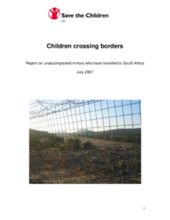This study aimed to gain insight into the migration experiences of children who cross international borders unaccompanied. The research took place in three main sites, namely, Johannesburg, the border with Zimbabwe (predominantly in Musina) and the border with Mozambique (predominantly in Malelane and Komatipoort).
The research aimed to provide information on: a) the routes of migration; b) who children migrated with; c) the reasons for migration; d) how these children obtained basic necessities such as food, money, shelter, health care and safety, and e) and their experiences of arrest, deportation and violence.
The study found that there is a gendered pattern of migration to South Africa, with boys more likely to migrate alone than girls. This gendered pattern of migration was most striking among children living on the border areas. Additionally, the study showed that children are migrating alone at a very young age. This was also particularly the case for children migrating from Zimbabwe and Mozambique. This research indicated that children who migrate alone do so because of a combination of the HIV epidemic, poverty and the lack of educational opportunities in their country of origin.

